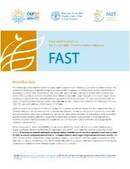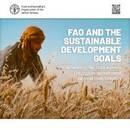Publications
The State of Food and Agriculture 2022 looks into the drivers of agricultural automation, including the more recent digital technologies. Based on 27 case studies, the report analyses the business case for adoption of digital automation technologies in different agricultural production systems across the world. It identifies several barriers preventing inclusive adoption of these technologies, particularly by small-scale producers. Key barriers are low digital literacy and lack of an enabling infrastructure, such as connectivity and access to electricity, in addition to financial constraints. Based on the analysis, the publication suggests policies to ensure that disadvantaged groups in developing regions can benefit from agricultural automation and that automation contributes to sustainable and resilient agrifood systems.
The aspirational goal of FAST is to implement concrete actions that would result in improving the quantity and quality of climate finance contributions to transform agriculture and food systems by 2030, to support adaptation and maintain a 1.5-degree pathway whilst supporting food and economic security.
The FAST initiative will be a multi-stakeholder partnership acting as an accelerator to transform agrifood systems to deliver triple wins: for people, for climate and for nature.FAST is designed as a catalyst, building on ongoing global and regional initiatives and coalitions to drive effective actions, and avoiding duplication.
FAO’s latest forecasts point to somewhat easing of market conditions for basic foodstuffs. However, increased climate variability, conflicts and geopolitical tensions, bleak economic prospects, soaring agricultural input costs and export restrictions continue to pose challenges to global food commodity market stability. Issued twice a year, the November issue of the Food Outlook offers market summaries of FAO’s reviews of market supply and demand trends for the world’s major foodstuffs, namely cereals, oilcrops, sugar, meat, dairy, and fish. It also looks at trends in food import bills, agricultural input import bills, Ocean freight rates and FAO food price indices. The Markets and Trade Division of FAO, as part of the Global Information and Early Warning System (GIEWS), produces and publishes the Food Outlook to enhance transparency in global food markets. Concerning global cereal markets, the Food Outlook maintains a close synergy with the quarterly GIEWS publication Crop Prospects and Food Situation.
his catalogue aims to improve the dissemination and outreach of FAO’s knowledge products and overall publishing programme. By providing information on its key publications in every area of FAO’s work, and catering to a range of audiences, it thereby contributes to all organizational outcomes.
From statistical analysis to specialized manuals to children’s books, FAO publications cater to a diverse range of audiences. This catalogue presents a selection of FAO’s main publications, produced in 2022 or earlier, ranging from its global reports and general interest publications to numerous specialized titles. In addition to the major themes of agriculture, forestry and fisheries, it also includes thematic sections on climate change, economic and social development, and food safety and nutrition.
The Sustainable Development Goals (SDGs) belong to all of us. But amid resurgent conflict, climate havoc, and social and health crises, we risk losing sight of them. Even so, they represent our best shot at a better future for people and planet. This publication shows how FAO and partners continue to work for the achievement of the SDGs, project by project, field by field, and country by country.






